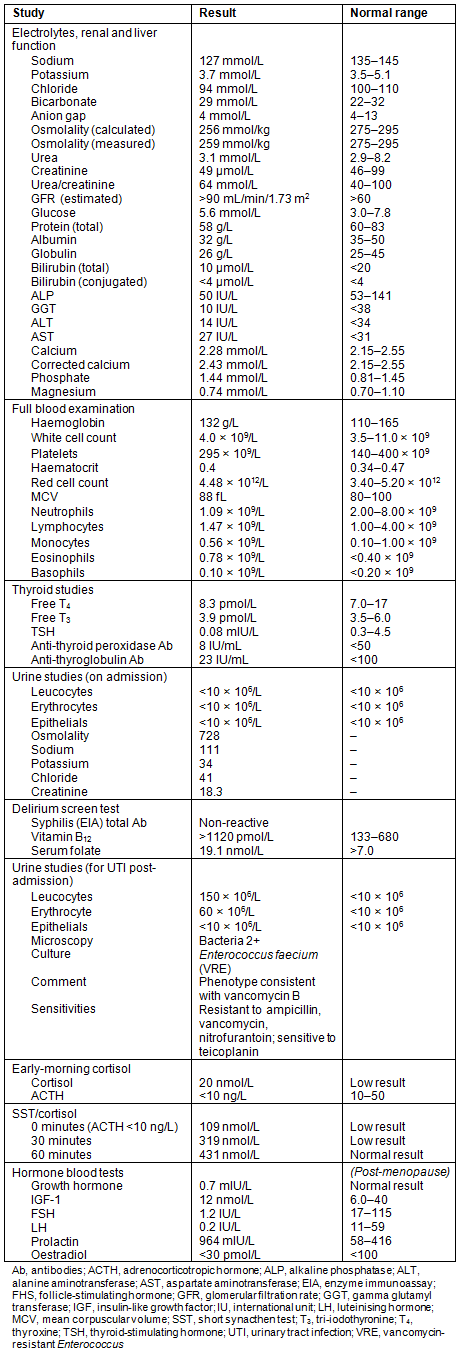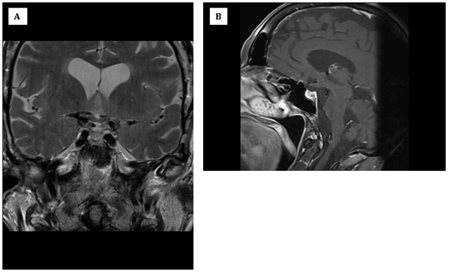Introduction
Delirium is common and its aetiology can be multifactorial. It is characterised by fluctuating behavioural disturbance, impaired cognitive function, reduced concentration, psychomotor changes, and disruption in sleep-wake cycles. Delirium is typically reversible once the causative factors are identified; however, it is often missed, resulting in increased morbidity and mortality1,2.
Context
Index case
A 75-year-old female from the Atherton Tablelands in North Queensland was admitted to Mareeba Hospital with a 1-month history of worsening confusion. (Mareeba Hospital is a 52-bed hospital servicing 20 000 people.) Her daughter reported the woman's increasing disorientation, weakness, fatigue, decreased mobility and oral intake, with functional decline progressing such that the patient became bed-bound and reliant on her daughter for all activities of daily living. Prior to this sudden decline the patient was living independently.
Past medical and surgical history consisted of treated Helicobactor pylori infection, bilateral rotator cuff syndrome, neck of femur and vertebral osteoporotic fractures, laparoscopic cholecystectomy, depression, hearing impairment, oesophageal stricture managed with dilatation and resolved third cranial nerve palsy with normal CT brain, MRI brain and carotid Doppler.
Her only medication on admission was escitalopram 10 mg daily for depression and there was no history of alcohol consumption or smoking.
The physical examination did not reveal any focal cause of the patient's presenting symptoms. Vital signs were within normal limits. There were no focal neurological signs and the initial mini-mental state examination (MMSE) score was 7/30, indicative of severe cognitive impairment.
On admission a diagnosis of delirium and functional decline for investigation was made. Baseline blood tests and a septic screen were performed and broad-spectrum antibiotics administered.
The following day the patient remained delirious and severe hypotension (65/40 mmHg) developed. Other vital signs were normal. A repeat clinical examination remained unhelpful, and further history was unobtainable due to her ongoing confusion and little collateral history. The impression was delirium and hypotension with a provisional diagnosis of sepsis of unknown origin. Treatment with intravenous fluids and broad-spectrum intravenous antibiotics continued, with blood pressure responding well to fluid challenge.
Laboratory investigation results are presented in Table 1. A chest X-ray and brain CT were unremarkable. The ECG showed a left bundle branch block. Serial blood cultures taken when the patient was not taking antibiotics were sterile.
Table 1: Results of laboratory investigations into prolonged delirium

Issue
Investigations revealed hyponatraemia, neutropaenia, eosinophilia and subclinical hypothyroidism in the setting of episodic hypotension, any one of which may have contributed to prolonged delirium1.
The hypotensive episodes, neutropaenia and eosinophilia persisted despite antibiotics and a negative septic screen, including a negative stool examination. Low thyroid-stimulating hormone (TSH), low/normal tri-iodothyronine (T3) and normal thyroxine (T4) with negative thyroid antibodies suggested subclinical hypothyroidism with possibly a central cause given the low TSH. The hyponatraemia in the setting of euvolaemia was thought to be secondary to escitalopram and hypothyroidism; however, it only partially resolved with cessation of escitalopram3. The low plasma sodium, low plasma osmolality, high urinary sodium and high urine osmolality were suggestive of syndrome of inappropriate antidiuretic hormone secretion (SIADH) and the sodium normalised with additional fluid restriction4. The MMSE improved from 7/30 to 22/30 with correction of the hyponatraemia, although some degree of cognitive impairment remained.
The sudden onset and rapid decline suggested a single diagnosis that amalgamated this range of medical findings. The provisional diagnosis unifying the findings in this case was adrenal insufficiency.
The features of hyponatraemia, neutropaenia, eosinophilia, hypotension and an SIADH-like picture observed in this case are described features of adrenal insufficiency5-7. Moreover, the low TSH is in keeping with underlying pituitary gland insufficiency5,7.
Adrenal insufficiency is a condition in which the lack of endogenous cortisol production by the adrenal glands is pathognomonic. Adrenal insufficiency can be due to pathologies at any level of the hypothalamic-pituitary-adrenal (HPA) axis. Diagnosis and the location of the pathology within the HPA axis depend upon the short synacthen test (SST). For the SST, a synthetic form of adrenocorticotropic hormone (ACTH) is administered and the peripheral blood is taken for cortisol samples at timed intervals to look for an adrenal response6,7.
The evidence in this case suggested adrenal insufficiency potentially secondary to pituitary malfunction, so an early-morning cortisol test and SST were arranged. Both the cranial nerve and visual field examinations were unremarkable despite the suspicion of pituitary disease.
Whilst awaiting the SST, the patient experienced a clinical deterioration with profound hypotension (65/30 mmHg) and fever. Given the clinical suspicion of adrenal insufficiency, these hypotensive episodes were now presumed to be caused by an Addisonian crisis.
Addisonian crisis is a well-documented complication of adrenal insufficiency, characterised by an insufficient endogenous steroid response to an acute illness, resulting in hypotensive shock6,7. Steroids are the mainstay of therapy to prevent mortality and should not be delayed while awaiting diagnostic tests6,7. Dexamethasone therapy can be considered in this pre-diagnostic phase because it does not interfere with the cortisol assays in the SST6.
The septic screen revealed a urinary tract infection secondary to vancomycin-resistant Enterococcus (VRE). Treatment with teicoplanin and intravenous fluids was initiated. Empiric dexamethasone was administered for presumed adrenal insufficiency prior to the SST then changed to hydrocortisone post-SST.
After hydrocortisone therapy the patient's improvement was dramatic. After 1 day of steroid therapy the patient's cognition had returned to her pre-morbid level, with an MMSE of 29/30. Clinically there was substantial improvement with the patient now awake, alert, orientated, with normal vital signs, and able to mobilise. Her first comment was, 'Where have I been? I feel like I've woken up from a terrible dream'.
The results of the SST confirmed the diagnosis of adrenal insufficiency (Table 1). The ACTH and cortisol were low prior to synacthen, with a substantial cortisol increase after delivery of synacthen, consistent with hypopituitarism5-7. This SST result combined with abnormalities in thyroid function implied that multiple pituitary hormones were affected. The remaining pituitary hormones were investigated (Table 1) and the patient was transferred to a tertiary facility for MRI brain and specialist endocrinology input.
The MRI brain revealed no pituitary adenoma (Fig1). Assessment of the results indicated that the adrenal, thyroid and gonadal axes were suppressed and the prolactin level was high. Vitamin D levels were also low.
The patient was transferred back to Mareeba Hospital for rehabilitation and was eventually discharged home at her pre-morbid state of living independently. Discharge medications were aspirin, calcium, vitamin D, hydrocortisone 10 mg mane/10 mg mid/4 mg nocte, and thyroxine 50 µg mane.
At outpatient endocrine follow-up, the final diagnosis was idiopathic pituitary insufficiency with deficiencies in ACTH, TSH, luteinising hormone and follicle-stimulating hormone, but preservation of growth hormone (Table 1). The prolactin level was elevated but not consistent with prolactinoma8. The angiotensin-converting enzyme level and iron studies were normal indicating sarcoidosis and haemochromatosis were unlikely aetiologies9. Given the background of resolved but undiagnosed third cranial nerve palsy and now idiopathic pituitary insufficiency, an inflammatory condition such as histiocytosis may be considered9. However, confirmation of such a diagnosis would require a brain biopsy, the substantial risks of which were a considerable deterrent to all parties involved.

Figure 1: Coronal (a) and sagittal (b) MRI images of the patient's
pituitary gland, indicating absence of pituitary adenoma.
Lesson learned
Dangers of misdiagnosis
This case of prolonged delirium had a treatable aetiology of idiopathic pituitary insufficiency, which can be difficult to detect. It is important to consider reversible causes of cognitive impairment because misdiagnosis can lead to adverse outcomes and increased mortality. In this case, the patient was delirious and bed-bound, which may have culminated in her death or placement in a nursing home; however, the correct diagnosis and treatment of the underlying cause led to a full recovery.
Challenges of rural medicine
To optimise patient care rural doctors are required to continually extend their boundaries of practice. The disparity between the health status of rural and metropolitan Australians is well established10,11. Specialist medicine can be limited in rural areas creating access issues and barriers to optimal health service delivery. Access and timely return of investigations in rural practice is challenging.
In this case the synacthen required a special order and the laboratory facilities were limited. These challenges put the onus back onto the rural generalist to practise closer to the line of specialist medicine, which can push the boundaries of their usual expertise10,11. This case illustrates a significant clinical challenge to a rural medical practice that would qualify in urban areas for specialist inpatient management.
Conclusion
This report presents a case of prolonged delirium in a rural hospital, where a diagnosis of idiopathic pituitary insufficiency was made. Optimal management allowed the patient to 'wake up from a terrible dream'. This case is unique because it illustrates the adaptation of a rural hospital to optimally manage a complicated medical case, and it provides an insight into the barriers faced in rural internal medicine practice.
References
1. Inouye SK. Delirium in older persons. New England Journal of Medicine 2006; 354: 1157-1165.
2. American Psychiatric Association. Diagnostic and Statistical Manual, 4th ed. Washington, DC: APA Press, 1994.
3. Adrogué HJ, Madias NE. Hyponatremia. New England Journal of Medicine 2000; 342: 1581-1589.
4. Ellison DH, Berl T. Clinical practice. The syndrome of inappropriate antidiuresis. New England Journal of Medicine 2007; 356: 2064-2072.
5. Liamis G, Milionis HJ, Elisaf M. Endocrine disorders: causes of hyponatremia not to neglect. Annals Of Medicine 2011; 43(3): 179-187.
6. Zaloga GP, Marik P. Hypothalamic-pituitary-adrenal insufficiency. Critical Care Clinics 2001; 17(1): 25-41.
7. Arlt W, Allolio B. Adrenal insufficiency. Lancet 2003; 361(9372): 1881-1893.
8. Melmed S, Casanueva FF, Hoffman AR, Kleinberg DL, Montori VM, Schlechte JA et al. Diagnosis and treatment of hyperprolactinemia: an Endocrine Society Clinical Practice Guideline. Journal of Clinical Endocrinology & Metabolism 2011; 96(2): 273-288.
9. Toogood AA. Hypopituitarism: clinical features, diagnosis, and management. Endocrinology and Metabolism Clinics of North America 2008; 37(1): 235-261.
10. Bourke L, Sheridan C, Russell U, Jones G, DeWitt D, Liaw S. Developing a conceptual understanding of rural health practice. Australian Journal of Rural Health 2004; 12(5): 181-186.
11. Smith J, Hays R. Is rural medicine a separate discipline? Australian Journal of Rural Health 2004; 12(2): 67-72.
